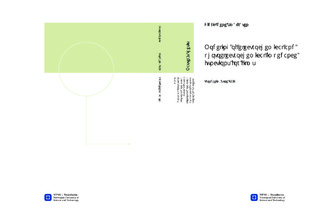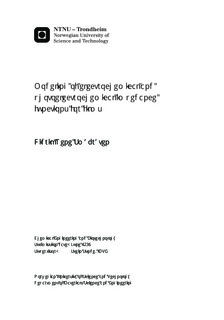| dc.description.abstract | The aim of this study was to develop mathematical models for electrochemical and photoelectrochemical impedance transfer functions for mixed conducting films. These models include electrochemical impedance spectroscopy (EIS), photoelectrochemical impedance spectroscopy (EIS), intensity-modulated photovoltage spectroscopy (IMVS), and intensity-modulated photocurrent spectroscopy (IMPS) for mixed conducting photoelectrochemical thin films, and intensity-modulated photocurrent spectroscopy (IMPS) for mixed conducting microporous thin films. In addition a short study of the step size dependency of the convergence for numerical modeling approach using Newman's BAND(J) subroutine to solve a second order diffusion equation has beed performed.It was found that the derived photoelectrochemical impedance (EIS) transfer function and the intensity-modulated photocurrent spectroscopy (IMPS) transfer function were dependent on the degree of mixed conductivity, while the intensity-modulated photovoltage spectroscopy (IMPS) transfer function was independent with degree of mixed conductivity. This was explained by the steady-state concentration profiles for the extreme cases of t+=1 and t+=t-=0.5. The concentration at solution interface increases with increasing light intensity when a sufficiently large light adsorption coefficient is assumed. For the pure electrical conducting system (t+=1), the concentration close to the support is constant. So when the current oscillates, only the concentration close to the solution interface oscillates. For the mixed conducting system (t+=0.5), concentration at both the electrode interfaces oscillates. Thus, the electrode kinetics at both interfaces affect the impedance measurements for an applied current density. Under open circuit conditions for IMVS measurements, only the photogenerated charge carriers close to the solution will contribute to the impedance, since the applied current is zero and the transfer function is independent of the transport numbers.Newman's BAND(J) subroutine has been proven to be valid to solve partial differential equations with complex numbers, needed to calculate impedance spectra, in previous work. It was found in this study that the convergence of the BAND(J) subroutine does not follow the expected convergence toward the numerical solution with decreasing step size. One possible source for this unexpected trend was proposed to be that the error related to this numerical approach is dependent on higher derivatives of the solution. It was advised that a Richardson's iteration method study for higher order derivatives should be performed for this routine to find the appropriate error dependency.The electrochemical impedance transfer function for the mixed conducting thin film electrode showed a reflective-like behavior, as expected from previous work. A dome in the low frequency region of the impedance plane plot was observed. The dome occurs at a frequency equal to the effective rate constant k. Thus, this dome corresponds to the charge limiting process of recombination across the bulk electrode. By decreasing the rate constant of recombination, the impedance increases, in accordance with previous work.The photoelectrochemical impedance transfer function for the mixed conducting thin film electrode showed two domes in the impedance plane plot with different imaginary parts in the low frequency region of the impedance spectrum corresponding to two distinct charge transfer limiting processes in opposite directions. It was found that the current associated with charge transfer limiting process oscillating in the same direction as the potential occurred at a frequency equal to the chosen effective rate constant k. Thus, this dome corresponds to the charge limiting process of recombination in the bulk of the electrode material. The current oscillating in the opposite direction of the potential was assumed to be associated with a back charge transfer process between the electrode and the electrolyte, and should be described by the electrode kinetics at the solution interface. In the high frequency region, the system is diffusion limited, and for high light intensities the system shows a reflective-like behavior.The intensity-modulated photovoltage spectroscopy (IMVS) impedance transfer function for the mixed conducting thin film electrode showed one dome in the impedance plane plot. It was found that the dome occurs at a frequency equal to the chosen value for the effective rate constant k. Thus, the dome corresponds to the charge limiting process of recombination across the bulk electrode. For sufficiently low k-values, the system is charge transfer limiting in the low frequency region, and diffusion limiting in the high frequency region.The intensity-modulated photocurrent spectroscopy (IMPS) impedance transfer function for the mixed conducting thin film electrode showed two distinct domes in the impedance plane plot in the same quadrant for large rate constants and applied steady state current densities, corresponding to two different charge limiting processes. It was found that one of the domes occurred at a frequency equal to the chosen value of the effective rate constant k. Thus, this dome corresponds to the charge limiting process of recombination across the electrode. The other dome is assumed to correspond to back charge transfer with the electrolyte, and the rate of the charge transfer should be described by the electrode kinetics at the solution interface. By decreasing the applied current density and increasing the light intensity, a shift in the quadrant of the impedance plane plot was observed. The proposed explanation to this is the competition between recombination and charge generation to keep the potential constant. When the rate of generation exceeds the recombination, the charge transfer at the solution interface changes direction in order to maintain a constant potential. This was investigated in more detail for steady-state conditions, where it was found that for high rate constants the current increases with increasing light intensity to keep a constant potential, in accordance with Fick's first law of diffusion. For low rate constants the current decreases with increasing potential, thus the charge transfer between the electrode and electrolyte changes sign and the net current density is in opposite direction than the light intensity. For intermediate rate constants, a change from increasing to decreasing current with increasing light intensity is observed. This indicates that the recombination process accommodates for the increased current by increasing the light intensity in order to keep the potential constant for low light intensities. At a threshold light intensity, the current density is changing from increasing to decreasing with increasing light intensity, indicating that the recombination cannot accommodate for the increased current by increasing the light intensity to keep the potential constant, and the potential is kept constant by changing the direction of the charge transfer between electrode and electrolyte.The intensity-modulated photocurrent spectroscopy (IMPS) transfer function for the microporous mixed conducting thin film electrode showed a reflective-like behavior, where a charge transfer limiting process in the lower frequency limit and a diffusion controlled process in the high frequency region where observed. The charge limiting process was found to be the recombination process described by the effective rate constant k. The model, however, seemed to break for low rate constants, and a further study of this model was suggested.A limitation of the derived model was that the steady-state concentration under zero light and zero illumination is zero. In previous work, an additive term in the steady-state concentration expression corresponding to the equilibrium concentration was proposed. By including an additive term directly does not fulfill the steady-state diffusion equation as written. One possible solution was proposed, in which the equilibrium concentration is introduced in the diffusion equation, and the diffusion equation is then solved with appropriate boundary conditions. This was suggested to be studied in more detail in further work. | nb_NO |

